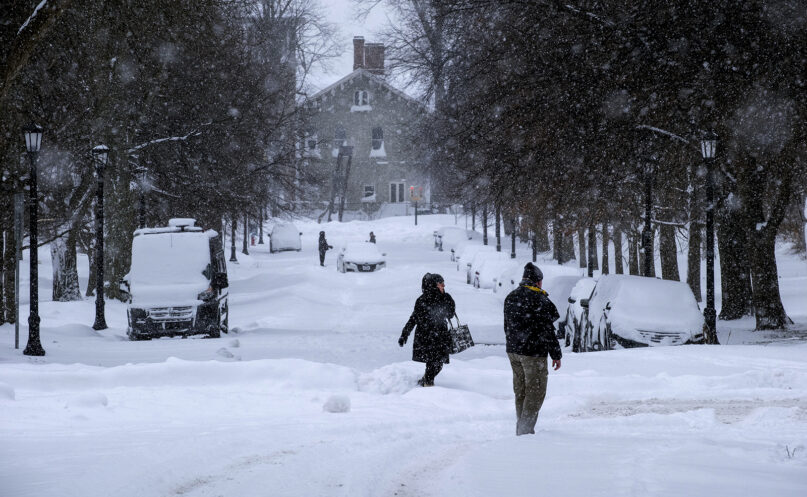(RNS) — My friend Ravi has the most annoying saying: “There’s no such thing as bad weather, just bad preparation.”
Easy for him to say. Ravi lives in Florida, where life is always sunny.
But for someone like me, who grew up in the scorching heat of South Texas and spent his summers in the even more scorching heat of Punjab, and who has now lived in New York City, I’m more convinced than ever: Winters suck.
In December, I visited Washington, D.C., for a pair of events: a holiday party for work and a dinner party to celebrate my new book. I had been excited for the gatherings and glad to be there. I’d dreamed of my own book party for years. But as the day got colder and rainier, my mood dampened with it. Trudging the six blocks from one party to the next, umbrella in hand, avoiding puddles but my socks getting soaked anyway — all I could think of was Ravi’s dumb saying. “No bad weather my ass,” I mumbled to myself.
Annoyed at my annoyance and wanting to enjoy the book party, I began an internal exercise. I reminded myself how lucky I was to be at these two celebrations with friends and colleagues I cared about. I reflected on how fortunate I was that my wife could take a day off work so I could leave things to her at home and enjoy my trip.
I thought about all my privileges that made it possible to be right here, in this place, at this moment. And with that, I could feel my mood shift, from one of annoyance to one of gratitude. A two-minute meditation. That’s all it took.
This simple story reflects how I think about resilience. It’s not about a superhuman feat that’s only accessible to a select few. It’s not about overlooking the hardships before us. It’s not even about ignoring the intricacies of life that annoy us. I think of resilience as confronting difficulties head-on — however large or small they might be — with the confidence that we can maintain our happiness through whatever we experience.
Resilience is about having the tools available and ready, so that when we feel challenged, we can see those challenges in their fullness and then choose to embrace them anyway. In a way, resilience is a form of resistance, a way of telling life, “Go ahead and try your hardest. I’m going to find my way to happiness anyway.”
Our cultural views on resilience are too limited. We expect certain groups to be inherently resilient because of the hardships they face. We deflect our own responsibility to improve and address inequities because, as we say, “They’ll survive. They’re resilient.” We think of resilience as a switch that we can flick on and off depending on the circumstance.
What we don’t realize is that resilience can be so much more if we think about it differently.
Resilience helped me adjust my mood, and thank God it did. But that’s only part of the story. As I continued walking to the event, I wondered about my bias against rain. Where did that perception come from? I reflected on American culture, where we typically describe rainy days as gloomy, dreary, miserable; where we have nursery rhymes begging the rain to go away.
The South Asian culture of my heritage sees rain differently. For farmers and the people they feed, rain is lifegiving. And for these same communities, many of whom are accustomed to droughts, rain can be the difference between life and death.
Rain is beautiful and nourishing, to be appreciated and celebrated.
It’s also true that rain can be just as inconvenient and destructive there as anywhere else in our climate-challenged world. The region literally has a time of year known as “monsoon season.” And yet the cultural perception is hopeful and optimistic.
In reflecting on the two opposing viewpoints most familiar to me, a new question rose to the surface of my consciousness: What is it that enables some people to see the same phenomenon as something to endure, while others see it as something to celebrate?
While we might be taught to think of rainy days as a nuisance, we can also learn to see them differently. Rain is a symbol of all the gifts we’ve received that we did nothing to deserve and did nothing to earn.
Rain is grace.
The conditions were still the same. It’s my perspective that shifted. I walked into the book party, my heart feeling full and my spirit feeling full, too.
I don’t buy into the idea that we endure the bad so we may understand good. The adage “What doesn’t kill you makes you stronger” may be true in some instances, but not always. I do believe that we can make simple shifts in our thinking that will change how we experience the world. With the right intention and preparation, we can meet those difficult moments and find ways to live into them with joy and hopefulness.
That rainy day in Washington, I was able to lean into the tools of resilience that I had developed over the years to counterbalance how crappy I had felt in the moment. A quick two minutes of introspection brought me back to equipoise. That’s all I needed then.
But now, in reflecting on different cultural perspectives on rain, I’m struck by a different possibility. It’s not just that we can prepare ourselves to face new challenges with resilience.
Maybe we can reframe our entire view of what constitutes hardship.
Maybe we can feel sweetness in the midst of pain.
Maybe joy and difficulty aren’t mutually exclusive.
Maybe, as my friend Ravi would say, there’s no such thing as bad weather.






